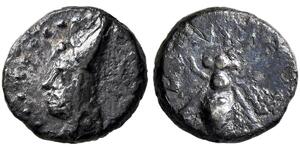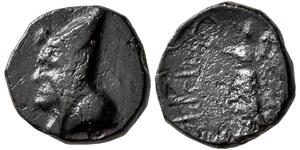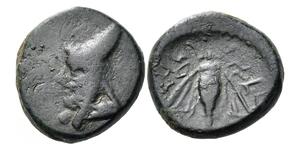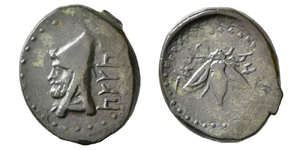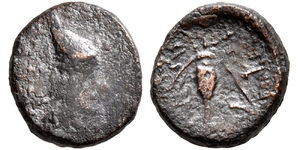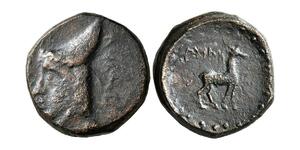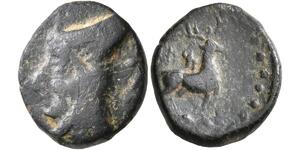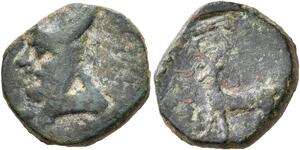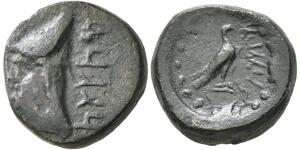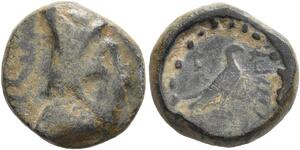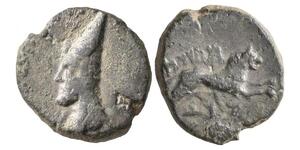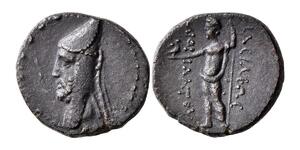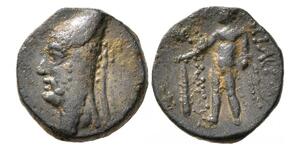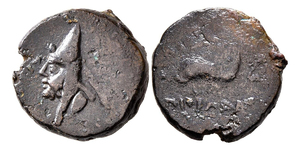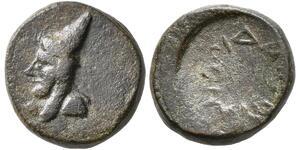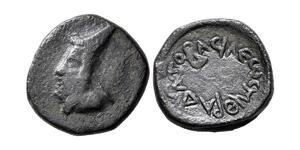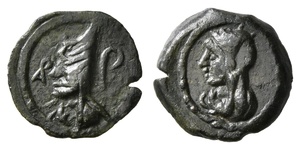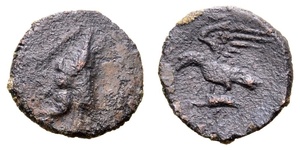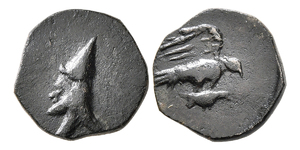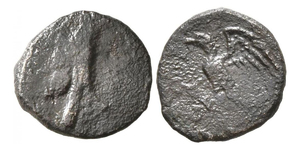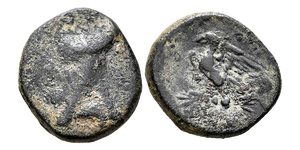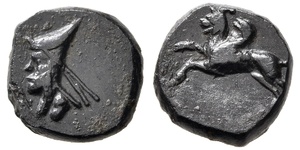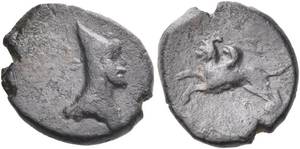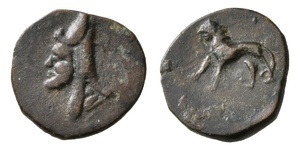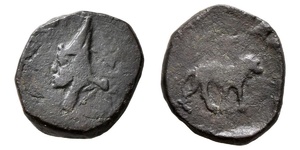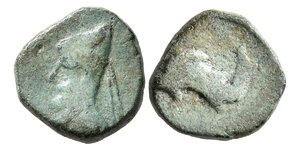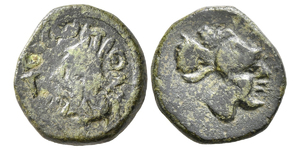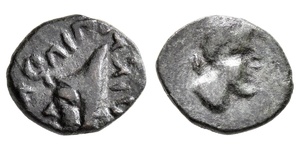Mithradates, Satrap of Armenia 180-154 BC
Mithridates emerged as a pivotal figure in Lesser Armenia during the mid-2nd century BC and can be identified with the “Mithradates, satrap of Armenia” named by Polybius in a 179 BC treaty that ended hostilities between Eumenes II of Pergamon, Pharnaces I of Pontus, and others. Although referred to as a satrap in that agreement, he appears to have been exercising de facto independent authority rather than acting as a mere Seleucid appointee. His rise likely followed the Seleucid defeat at Magnesia in 189 BC, after which various local powers, including Greater Armenia, formally established or expanded their dominions. Mithridates took a similar path, issuing coinage with Aramaic legends—an echo of the Achaemenid and imperial tradition—before adopting Greek inscriptions that proclaimed him as a basileus. This bilingual approach mirrors the numismatic practice of Artaxias I in Greater Armenia and indicates a shared cultural and ideological framework across the Armenian plateau. Polybius also records that Mithridates supported Attalus of Pergamon in 154 BC, which attests to his continuing reign at least until that date. His father is not explicitly named in the surviving sources, but historical inference suggests an Iranian or Armenian noble lineage.
Mithridates’ coinage is broadly divided into four categories, each illustrating a distinct phase in the kingdom’s numismatic and ideological development. The first category comprises coins inscribed in Aramaic, likely signifying continuity with earlier Achaemenid traditions. The second category uses Greek legends, marking a shift toward broader Hellenistic recognition of Mithridates as a basileus. A third, labeled “epigraphic coinage,” features brief inscriptions that omit clear titles or elaborate legends. Lastly, a group of atypical issues deviates from standard models in both design and legend, reflecting possible experimentation or transitional minting practices during this transformative period.
Aramaic-Legend Coinage
This first category encompasses coin types inscribed in Aramaic, which appear to form the earliest phase of Mithridates’ minting activities. The Aramaic legends themselves link to a broader Achaemenid heritage that continued to influence regional practices long after the fall of the Persian Empire. Within this group, motifs such as the bee and the deer suggest the resonance of Hellenistic iconography adapted to an Armenian context: the bee likely evokes the goddess Artemis in its Greek origin, while here pointing to the Armenian goddess Anahit. References to Nike walking, possibly celebrating a military or political triumph, reinforce the notion of Mithridates’ consolidation of power. One of the most noteworthy aspects of these coins is the appearance of a silver issue, including what might be the earliest hemidrachm known from the Armenian plateau. This innovation in silver coinage could be linked to the recruitment of mercenaries or broader military needs, dovetailing with the historical scenario in which Mithridates strengthened his autonomy following the Seleucid defeat at Magnesia in 189 BC. The Aramaic legends, consistent across these types, highlight Mithridates’ initial stance as a local satrap or quasi-independent figure who drew on the linguistic and cultural continuity of the region rather than immediately resorting to Greek inscriptions.
Greek-Legend Coinage
The second category reflects a turning point in which Mithridates presents himself more explicitly to the Hellenistic world, adopting Greek inscriptions that include his name and, in some cases, his royal title. Types within this category feature well-known Hellenistic deities: Nike walking again appears, symbolizing victory; Zeus stands in a pose reminiscent of Seleucid coin types, but in an Armenian framework, he might represent Aramazd. Similarly, Heracles likely corresponds to the Armenian god Vahagn, identifiable by the hero’s club. A particularly striking example is the image of a dolphin, which may serve as a local interpretation of the vishap, a water-associated mythological being in Armenian tradition. Collectively, these designs indicate a deliberate effort to participate in the shared cultural language of the Hellenistic monarchies while also asserting distinctively Armenian elements. The gradual shift from mere personal name (ΜΙΘΡΑΔΑΤΟΥ) to the full royal title (ΒΑΣΙΛΕΩΣ ΜΙΘΡΑΔΑΤΟΥ) suggests that Mithridates’ authority evolved into kingship recognized beyond his own borders, a transition possibly tied to the post-179 BC treaty negotiations recorded by Polybius.
Epigraphic Coinage
In contrast to the more straightforward Aramaic or Greek legends, the third grouping comprises coin types that either carry minimal inscriptions or feature brief epigraphic devices. Some pieces, for instance, show only a single letter or a small segment of the gubernatorial tiara on the reverse, suggesting an intermediate stage or a special issue. Another notable example displays the bust of a veiled woman, which might depict the queen, a prominent female relative, or a local deity; the absence of a clear legend leaves this identity uncertain. Equally intriguing are coins depicting an eagle holding prey in its talons, an emblem with deep roots in Armenian heraldry and evident parallels in both Urartian art and medieval Armenian symbolism. These types show how certain recurring images, especially the eagle, functioned as longstanding vehicles of royal or aristocratic identity. Placed between or alongside Aramaic and Greek coinages, these epigraphic issues highlight the experimental or transitional character of Mithridates’ mint, reflecting both continuity of local emblems and the gradual uptake of broader Hellenistic forms of self-presentation.
Atypical Coinage
The final set, composed of a small number of coin types, stands apart due to its irregular features in legends, iconography, or style. Although they share some affinities with earlier issues, they do not align neatly with either Aramaic, Greek, or minimal epigraphic norms. Their anomalies could stem from specialized one-off mints, transitional die engravers, or an attempt to cater to a distinct audience, possibly during a short-lived phase of uncertainty or succession. Because these issues sometimes retain only partial inscriptions or incorporate designs not found in the main series, they illuminate the complexity of Mithridates’ coinage toward the end of his reign (or potentially that of an immediate successor). While specific interpretations remain tentative, this atypical category underscores that numismatic practices under Mithridates were not monolithic, but could vary according to local needs, changing political contexts, or evolving minting conventions on the Armenian plateau.
Undeciphered Aramaic Coinage
Two final coin types remain outside the main four categories because their Aramaic legends have yet to be deciphered. Although they share stylistic and metrological traits with earlier issues in the corpus, the inscriptions resist coherent reading, prompting varied hypotheses about their place in Mithridates’ sequence or a possible successor’s reign. Scholars have proposed that shifts in local scribal practices, or even experimental die engraving, may explain why the text is now indecipherable. Regardless, these two coin types offer valuable insight into the ongoing evolution of Armenian numismatic traditions, illustrating that the language and iconography continued to adapt even after Mithridates had firmly asserted his authority. Further research into the script and any potential archaeological contexts will be necessary to clarify their precise chronological or dynastic significance.

